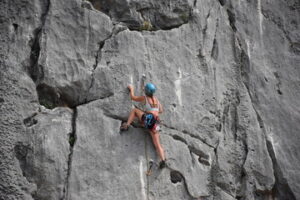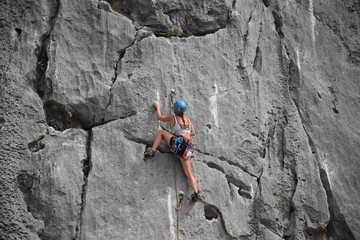Alta Climbing Gilbert demands both physical strength and mental focus. It challenges the body’s ability to push upward while balancing control and precision. Every step requires calculated effort and trust in technique. Climbers must understand their limits while testing their strength.
Different styles of climbing present unique challenges. Indoor climbing focuses on technique and strength training. Outdoor climbing requires adaptability to natural surfaces. Climbers must adjust to varying conditions and rock formations.
Training for climbing involves building core strength and flexibility. Climbers rely on grip strength, balance, and strategic foot placement. Core muscles provide stability during challenging maneuvers. Flexibility allows for smoother transitions between holds.
Mental preparation is as important as physical training. Climbers must visualize routes and anticipate challenges. Overcoming fear and uncertainty builds confidence. Mental focus enhances problem-solving and decision-making.
Safety is essential in climbing. Proper gear and harnesses prevent injury during falls. Regular checks of ropes and anchors ensure reliability. Climbers must trust their equipment and climbing partners.
Route reading is a vital skill in climbing. Identifying holds and footholds helps plan the ascent. Climbers must adjust to changing conditions and surface textures. Quick decision-making improves efficiency and safety.
Grip strength determines success in climbing. Different types of holds require varied hand positioning. Open hand grips offer control, while crimping allows for precise holds. Finger strength training enhances grip endurance.
Foot placement is key to maintaining balance. Precise positioning on small holds increases stability. Proper technique reduces strain on arms and improves climbing efficiency. Climbers often rely on friction and pressure to secure footing.
Flexibility increases reach and maneuverability. Stretching and mobility exercises improve range of motion. Flexibility helps with high steps and wide reaches. Maintaining body tension allows for smoother movement.
Endurance is critical for long climbing sessions. Climbers train by increasing climbing duration and intensity. Resting on secure holds conserves energy. Strategic pacing prevents muscle fatigue and improves overall performance.
Breathing techniques help control tension and focus. Steady breathing calms the nervous system during challenging climbs. Proper oxygen flow reduces muscle fatigue. Controlled breathing improves mental clarity and decision-making.
Problem-solving enhances climbing success. Climbers must analyze routes and adjust techniques mid-climb. Overcoming unexpected obstacles builds adaptability. Quick thinking and creativity improve climbing performance.
Fear management is a core aspect of climbing. Climbers face the fear of falling and failure. Building confidence through controlled practice reduces anxiety. Trusting in skills and preparation builds mental resilience.
Climbing shoes provide grip and precision. Tight fits and specialized rubber enhance surface contact. Proper shoe selection depends on climbing style and surface type. Well-maintained shoes improve performance and safety.
Belaying requires trust and communication. The belayer controls the rope and ensures the climber’s safety. Clear signals and consistent tension maintain control. Trust between climber and belayer strengthens performance.
Weather conditions impact outdoor climbing. Rain and humidity affect rock grip and surface texture. Wind and temperature changes alter muscle performance. Climbers must adapt to shifting environmental factors.
Rest and recovery improve climbing strength. Muscle repair and flexibility increase with proper rest. Stretching and hydration aid muscle recovery. Balanced training and rest prevent injury and fatigue.
Cross-training supports climbing performance. Strength training, yoga, and cardio improve overall fitness. Cross-training builds muscle balance and endurance. Diversified workouts prevent overuse injuries.
Climbing communities offer support and motivation. Experienced climbers share techniques and advice. Group climbing fosters teamwork and trust. Learning from others accelerates skill development.
Bouldering emphasizes short, powerful movements. Climbers rely on grip strength and dynamic positioning. Quick bursts of power define successful bouldering. Problem-solving in bouldering develops climbing adaptability.
Sport climbing involves lead climbing on secured routes. Climbers clip into pre-set anchors for safety. Route planning and stamina define sport climbing success. Strong mental focus enhances lead climbing performance.
Trad climbing requires placing protection into natural rock features. Climbers carry gear and set anchors along the route. Technical knowledge and experience improve safety and efficiency. Trad climbing develops problem-solving and adaptability.
Free solo climbing relies entirely on physical and mental strength. Climbers ascend without ropes or protective gear. Absolute focus and confidence define free solo success. Risk management and mental control are critical.
Indoor climbing gyms provide year-round training opportunities. Artificial holds and walls simulate outdoor conditions. Adjustable routes and climbing challenges improve technique. Indoor climbing fosters a controlled training environment.
Chalk improves grip and reduces moisture. Climbers apply chalk to hands and fingers. Proper chalk application prevents slipping on holds. Chalk management enhances grip consistency.
Fingerboards strengthen grip and finger strength. Climbers train on fingerboards to target hand muscles. Gradual progression improves finger endurance. Fingerboard training enhances hold control and grip stability.
Dynamic movements require controlled power and coordination. Climbers use momentum to reach distant holds. Proper body positioning and timing improve dynamic success. Fluid movement reduces energy waste and increases efficiency.
Static movements rely on strength and control. Climbers engage core muscles and maintain tension. Static positioning improves balance and precision. Controlled movement conserves energy during climbs.
Downclimbing improves control and technique. Climbers practice reversing routes to develop muscle memory. Controlled descent enhances balance and grip strength. Downclimbing reinforces route awareness and problem-solving.
Flexor and extensor muscle balance prevents injury. Climbers strengthen opposing muscle groups for joint stability. Balanced muscle training reduces overuse injuries. Improved muscle balance enhances overall climbing strength.
Body tension improves climbing efficiency. Engaging core muscles stabilizes body position. Controlled tension improves grip strength and reach. Strong body tension reduces energy waste.
Visualization enhances climbing strategy. Climbers mentally map routes and anticipate challenges. Visualization improves decision-making and route efficiency. Confidence increases with mental rehearsal.
Climbing challenges both the mind and body. It requires strength, flexibility, and problem-solving skills. Overcoming fear and adapting to conditions builds resilience. Mastering technique and mental focus leads to climbing success.
Environmental awareness supports responsible climbing. Respecting natural surfaces reduces impact on rock formations. Ethical climbing practices preserve climbing areas for future generations. Sustainable climbing ensures long-term access and enjoyment.
Climbing competitions test strength and mental focus. Timed routes and scoring systems challenge performance. Competitive climbing requires strategy and adaptability. Success depends on preparation and mental resilience.
Multi-pitch climbing extends routes over several segments. Climbers rest at anchor points between pitches. Efficient gear management and communication improve success. Multi-pitch climbing requires endurance and strategic planning.
Speed climbing emphasizes quick ascents and precise movements. Climbers race against the clock to complete routes. Fast decision-making and controlled technique define success. Speed climbing builds strength and mental focus.
Alpine climbing combines technical rock and ice climbing. Climbers adapt to varied surfaces and weather conditions. Technical knowledge and physical strength determine success. Alpine climbing demands preparation and resilience.
Climbing builds confidence and mental strength. Facing challenges strengthens problem-solving and adaptability. Physical training improves strength and coordination. Overcoming climbing obstacles builds lifelong resilience.


